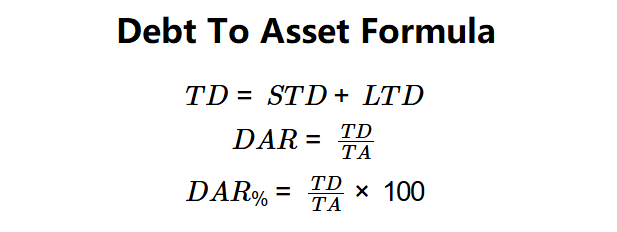1. What is the Debt-to-Asset Ratio Calculator?
Definition: This calculator computes the debt-to-asset ratio (\( DAR \)), which measures the proportion of a company’s assets financed by debt, along with the total debt used in the calculation.
Purpose: Helps investors, creditors, and managers assess a company’s financial leverage and risk, indicating how much of its assets are funded by debt.
2. How Does the Calculator Work?
The calculator uses the following formulas to compute the results:
Formulas:
\( TD = STD + LTD \)
\( DAR = \frac{TD}{TA} \)
\( DAR_{\%} = \frac{TD}{TA} \times 100 \)
Where:
- \( TD \): Total Debt (dollars)
- \( STD \): Short-Term Debt (dollars)
- \( LTD \): Long-Term Debt (dollars)
- \( TA \): Total Assets (dollars)
- \( DAR \): Debt-to-Asset Ratio (decimal)
- \( DAR_{\%} \): Debt-to-Asset Ratio (percentage)
Steps:
- Step 1: Determine total debt. Compute \( TD = STD + LTD \).
- Step 2: Determine total assets. Use the company’s total assets (\( TA \)).
- Step 3: Calculate debt-to-asset ratio. Compute \( DAR = \frac{TD}{TA} \) and \( DAR_{\%} = DAR \times 100 \).
3. Importance of Debt-to-Asset Ratio Calculation
Calculating the debt-to-asset ratio is crucial for:
- Financial Leverage: A higher ratio indicates greater reliance on debt, increasing financial risk
- Creditworthiness: Creditors use the ratio to assess a company’s ability to repay loans.
- Investment Decisions: Investors evaluate the balance between debt and assets to gauge stability.
4. Using the Calculator
Example 1: \( STD = \$50,000 \), \( LTD = \$150,000 \), \( TA = \$500,000 \):
- Step 1: \( TD = 50,000 + 150,000 = \$200,000 \).
- Step 2: \( TA = \$500,000 \).
- Step 3:
- \( DAR = \frac{200,000}{500,000} = 0.40 \).
- \( DAR_{\%} = 0.40 \times 100 = 40\% \).
- Results: \( TD = \$200,000 \), \( DAR = 0.40 \), \( DAR_{\%} = 40\% \).
A 40% ratio indicates 40% of assets are debt-financed, suggesting moderate leverage.
Example 2: \( STD = \$100,000 \), \( LTD = \$200,000 \), \( TA = \$400,000 \):
- Step 1: \( TD = 100,000 + 200,000 = \$300,000 \).
- Step 2: \( TA = \$400,000 \).
- Step 3:
- \( DAR = \frac{300,000}{400,000} = 0.75 \).
- \( DAR_{\%} = 0.75 \times 100 = 75\% \).
- Results: \( TD = \$300,000 \), \( DAR = 0.75 \), \( DAR_{\%} = 75\% \).
A 75% ratio indicates high leverage, posing greater financial risk.
Example 3: \( STD = \$20,000 \), \( LTD = \$30,000 \), \( TA = \$250,000 \):
- Step 1: \( TD = 20,000 + 30,000 = \$50,000 \).
- Step 2: \( TA = \$250,000 \).
- Step 3:
- \( DAR = \frac{50,000}{250,000} = 0.20 \).
- \( DAR_{\%} = 0.20 \times 100 = 20\% \).
- Results: \( TD = \$50,000 \), \( DAR = 0.20 \), \( DAR_{\%} = 20\% \).
A 20% ratio suggests low leverage, indicating financial stability.
5. Frequently Asked Questions (FAQ)
Q: What is a good debt-to-asset ratio?
A: A ratio below 50% is generally considered healthy, though it varies by industry; lower ratios indicate less risk, per Investopedia.
Q: Why include total debt in outputs?
A: Displaying \( TD \) clarifies the debt component, helping users verify calculations.
Q: Can the debt-to-asset ratio exceed 100%?
A: Yes, if total debt exceeds total assets, indicating insolvency or high financial risk.
Debt-to-Asset Ratio Calculator© - All Rights Reserved 2025
 Home
Home
 Back
Back
